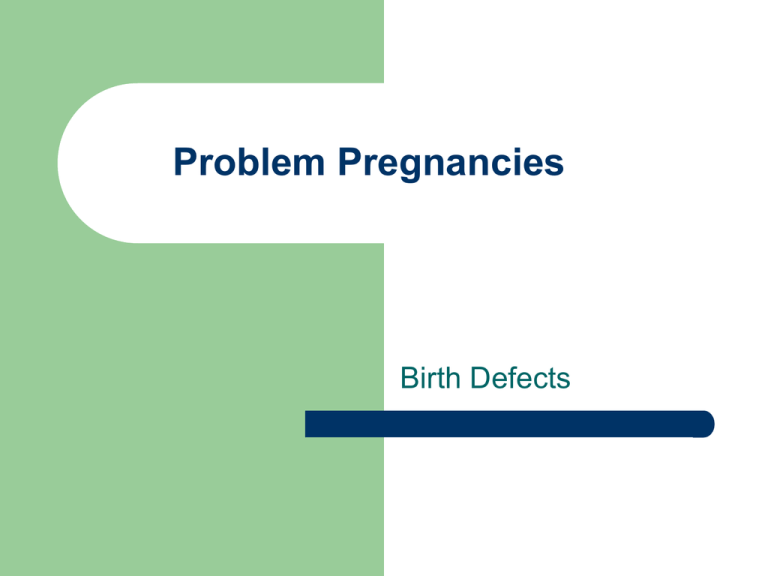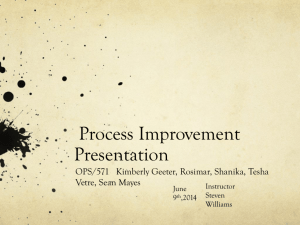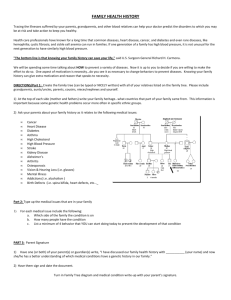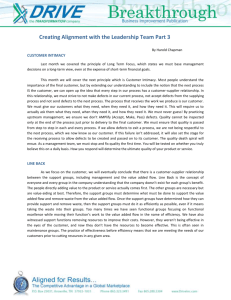Problem Pregnancies
advertisement

Problem Pregnancies Birth Defects The King and the Scratched Diamond Once there was a king, who had a beautiful, large pure diamond. There was no other diamond like it in the world. One day, it became deeply scratched. The king called his best diamond cutters, “I’ll promise you a great reward if you can remove the imperfection from my jewel.” But they could not. The king was very upset. . Many months later, a man came to the king. He promised to make the diamond even more beautiful than it ever had been. Impressed by the man’s confidence, the king consented. He watched as the man engraved an exquisite rosebud around the blemish and used the scratch to make its stem. --A parable of the Preacher of Dubno from Jewish folklore Conclusion This story can easily be equated to birth defects. Even though a child with a birth defect may not appear to be perfect, he/she still has great abilities and opportunities to apply himself/herself in life. Rather than emphasizing the problem, we must focus on the abilities of the person Discussion How may of you know someone who has had a problem pregnancy? Did she ever think anything like that could happen to her? No one plans on having a problem pregnancy, but everyone should know something about the potential problems in order to safeguard their health and the health of their fetus. FACTS About 150,000 babies are born each year with birth defects. The parents of one out of every 28 babies receive the frightening news that their baby has a birth defect There are over 4,000 known birth defects Birth defects are the leading cause of death in the first year of life What is a Birth Defect? An abnormality of structure, function or body metabolism (inborn error of body chemistry) present at birth that results in physical or mental disability or is fatal. What causes birth defects? Both genetic and environmental factors can cause birth defect. However, the causes of about 60% of birth defects are currently unknown. A single abnormal gene can cause birth defects. Every human being has about 100,000 genes that determine traits like eye color, hair, etc. Can birth defects be prevented? While the causes of most birth defects are not known, there are a number of steps a woman can take to reduce her risk of having a baby with a birth defect. Visit a health care provider for a pre-pregnancy check up. Especially if a woman has health problems When pregnant take daily multivitamin containing 400 mg of the B-vitamin folic Acid Avoid alcohol, drugs, smoking, prescription or overthe-counter medication with out checking with her health care provider. Factors that contribute to Birth Defects: ► ► ► ► ► ► ► ► ► Overweight Underweight Jewish decent African American Last birth was less than 12 month ago Has had a baby that weighed less than d ½ pounds Has had 3 or more miscarriages Has had more than 5 pregnancies Has had a still born baby ► ► ► ► ► ► ► ► ► ► Drinks alcohol Has personal habits that are different from most people Uses prescription drugs Has used street drugs Takes vitamins Drinks caffeine Has had exposure to chemicals Live in a home built before 1955 Constant exposure to cats Has had x-rays during pregnancy ► ► ► ► ► High blood pressure Thalassemia Diabetes Birth defects Hemophilia Mental retardation Sickle cell anemia Cystic Fibrosis Health problems: Genital herpes Gonorrhea Syphilis Epilepsy ► ► ► Diabetes High blood pressure Heart disease Anemia No immunizations against rubella Rh factor Miscarriage Can some birth defects be diagnosed before birth? Some birth defects can be diagnosed before birth. Some prenatal tests that can be taken are: Ultrasound Amniocentesis Chronic villus sampling Can birth defects be treated before birth? Advances in prenatal therapy now make it possible to treat some birth defects before birth. Prenatal surgery – urinary-tract blockages, rare tumors in the lungs, spina bifida, ph disease, Types of Birth Defects 1. Malformations present at birth defects such as congenital heart malformation, spina bifida (open spine), cleft palate, clubfoot 2. Inborn errors of metabolism Defects such as PKU, Tay Sachs disease 3. Blood Disorders Defects such as sickle cell anemia, hemophilia, thalassemia. 4. Chromosomal Abnormalities Conditions such as Down’s Syndrome, Klinefelter syndrome, Turner Syndrome. 5. Prenatal damage Cases include certain infections, drugs, maternal disorders such as diabetes, high blood pressure, Rh disease, umbilical cord accidents, difficult labor or delivery, premature birth. Preventing Birth Defects Nutrition Alcohol Smoking Drugs STDs Rubella Parasites Radiation Student Reports Divide students into groups of 3. Students will review and collect information from the March of Dimes and other resources. Report to the class information gathered about assigned birth defect.





